The Jewish history of Gorredijk
Sources: De Vlecke Gorredyck by Ernst Huisman
ISBN10 9061718996
ISBN13 9789061718994
Internet
Gorredijk is a village in the south east of the province of Friesland.
From the end of the 18th to the beginning of the 20th century there was a lively Jewish community in Gorredijk. The reason Jews chose to settle there was probably because the area enjoyed a period of economic growth at that time.
The first Jew to arrive in the village came from Leer in Germany in 1755. He lived in the first house on the Langewal, along the canal which runs through the centre of Gorredijk. He did not stay there long, nor did the few Jews who came subsequently. The first to settle there permanently was David Levi, who arrived with his wife in 1775. David Levi was born in the nearby village of Noordwolde in 1745, and was a son of Levi Levi and Golde David. When Napoleonic law made the adoption of surnames compulsory in 1811, he changed his patronymic Levi to the Friesian sounding Leefsma for his entire family. The Leefsma family was to play an important part in the Jewish community until the Nazis put a stop to it.
Levi Levi was not only the ancestor of all the Leefsmas, but also of many other Jewish families in Gorredijk, as two of his daughters married Jews who lived there, and children of another daughter also settled there. In small Jewish communities it often happened that cousins intermarried, a custom not prohibited by Jewish law.
Other surnames adopted by Jewish families in Gorredijk were Colthof, Van der Kaars, Kalf, Koopmans, Van Leer, Noordwal, Woudstra and Van der Wijk. Families with already existing names, like Cohen and Trompetter, kept them. Gorredijk had 49 Jewish inhabitants at the time, and in 1829 that number had almost trebled: of the 1537 inhabitants 130 were Jews.
The synagogue
The synagogue or shul (Yiddish for school) was used as a place of worship, study and social gathering. The first services in Gorredijk were held in a ‘home-synagogue’, in the home of a member of the Jewish community. In 1805 two brothers living in Gorredijk sold their properties (consisting of two rooms, an outhouse and land, including trees and crops) for the sum of 675 Caroliguilders (the currency at the time of Charles V), to be paid in three instalments. A year later one of the houses was demolished and a synagogue was erected in its place on the Langewal. The other house became the caretaker’s home. A ritual bath was installed in the room at the back.
It is not known who designed the synagogue, but going by the architectural style and the shape of the cupola, the recently built shul in Leeuwarden must have served as an example. The inauguration took place on 24 Adar II 5567, which corresponds to 4 April 1807. The shul had a simple classical façade and a pyramid-shaped roof. The cupola on top had a cast-iron weather vane in the shape of a stag. The triangular pediment above the façade bore the Hebrew inscription “Mah Tovu Ohalecha Yaakov”’ (How goodly are your tents, Jacob) and the inscription above the door read “mishkenotecha, Yisrael” (your dwelling places, Israel).
The women’s section was located above the entrance on the street. The Holy Ark, in which the Torah scrolls were stored, stood against the east wall. Its doors were concealed behind an embroidered curtain (parochet).
The Torah scrolls are a synagogue’s holy objects. They are handwritten on parchment and contain the five books of Moses. Every Shabbat a chazzan or a member of the community reads a portion out of them from a reading desk, called the bima. To ensure that the parchment is not touched, a Torah pointer is used, known as Yad.
Three brass chandeliers used to hang from the ceiling. The community owned several brass candle sticks as well as a brass candelabrum with eight branches: a Chanukah menorah or Chanukiah. Near the entrance to the men’s and women’s section stood a brass hand-washing basin.
A high point in the existence of the kehillah (congregation) was the synagogue’s centennial celebration in 1907. During the festivities homage was paid to Queen Wilhelmina and Prince Hendrik.
When after the Second World War a Jewish delegation from Leeuwarden (Friesland’s capital) inspected the dilapidated synagogue, the Torah scrolls in the Holy Ark were found intact, and some of the seats were still covered with prayer shawls and prayer books. However the condition of the building was such that it was beyond repair and it was demolished in 1954. The Holy Ark, the bima and the masonry with the Hebrew inscriptions were transferred to the Jewish community in Leeuwarden, which was still functioning at that time.
The ritual bath (mikvah)
A ritual bath with the necessary fittings was installed in the house of the shamash (caretaker) next to the synagogue on the south side. Peat was used to heat the water. The main purpose of the mikvah is ritual immersion, not bathing. Brides use it shortly before their wedding and married women after their monthly period. The mikvah is also used by the chazzan and his deputy before the High Holy Days (New Year and Day of Atonement), and for the immersion of crockery and cooking utensils so they can be used in a kosher kitchen. It was not until 1893 that a special house with bathing facilities was built.
School, community room and chazzan’s house
In 1817 the Jewish community bought for 450 guilders a house with two ‘rooms’ on the north side of the shul. They were used to house the chazzan, as a meeting place and a school for religious instruction. In 1827 the school had 22 pupils. In 1856 a new school and teacher’s residence were built to replace the old one. Twenty years later a school and community room were built on top, giving the building the appearance it still has today.
The Jewish community bought another house along the Langewal, next door to the old caretaker’s house with the mikvah. All these properties were inherited by the Dutch Israelite Community in Leeuwarden, which sold them shortly afterwards.
Care of the poor
In 1825 the kerkeraad (church council) bought a newly built house for two hundred fifty guilders, not far from the nearby village of Terwispel, to house a needy family. In 1854 two more houses were built behind it and a fourth was added later. Care of the community’s poor had originally been the responsibility of the Dutch Jewish Society for the Poor, but from the 1840s the village council made an annual contribution, which ceased however in 1865. From 1 January 1866 care of the Jewish and non-Jewish poor became the responsibility of the department for general poor relief in Gorredijk. The Jewish home for the poor was sold that same year.
The cemetery
It is not clear where the Jewish community in Gorredijk buried its Jews before 1804, but it could have been in the village of Noordwolde where there had been a Jewish cemetery since 1770. In June1804 the Jewish community signed a lease with Benedictus van Teijens for a piece of moorland of about 40 square metres in the Blindewijks Bosch, a forest in the Blindewijk district near the village of Kortezwaag. A year later this lease was changed to permanent usage for the sum of thirty Caroliguilders. According to the land registry the Jewish community has owned it ever since. A cemetery was duly constructed with a hut for the ritual cleaning of the dead on the east side. In 1820 a right of way was established by means of a lane through the Blindewijks Bosch, later also called Joadebosk (Jew’s forest).
The association Mazebeth Aben took care of the placement of gravestones. Some of the stones feature the so-called Cohanim hands, a sign that a Cohen was buried there. Cohanim are regarded as descendants of the priest Aharon ha-Cohen, the brother of Moses. Other stones show a hand pouring water from a jug, the symbol of the Levites who were caretakers of the temple and members of the tribe of Levi.
Gorredijk is situated in the Opsterland district, and in 1949 the disctrict took charge of the synagogue and with it the responsibility for management and upkeep. The NIK (The Organisation of Jewish Communities in the Netherlands) kept posession.
Organisation
From 1817 the Gorredijk synagogue became one of the five ringsynagoges (regional synagogues) in the province of Friesland, under the main synagogue in Leeuwarden. Villages such as Kortezwaag, Langezwaag, Heerenveen and Drachten all belonged to the Gorredijk ringsynagoge. In 1858 the rules governing the synagogue’s internal affairs limited the ringsynagoge to the Opsterland district.
A circumcision register in Hebrew, which was kept from 1775 to 1810, is now in the Leeuwarden state archives. Apart from the synagogue’s council and board there were several groups active, including a society for Talmud study, a burial organisation for men and one for women, an association responsible for the placement of gravestones, and a drama group. From the end of the 19th century there was also a branch of the Alliance Israelite Universelle.
During the French Period most Jews were ardent supporters of the House of Orange, which was not surprising after King Louis Napoleon’s decree of 1809 in which the use of Dutch was prescribed and the use of Yiddish in documents and sermons was prohibited.
When the French were driven out in 1813, a branch of the citizen’s militia was established in Gorredijk. Twenty Jews joined but as training took place on Saturdays (Shabbath), they could not take part. They therefore paid an expert to train them on another day.
Jews were not welcome everywhere. The rules of the society The Maatschappij tot Nut van 't Algemeen, which had as its aim the development of individuals and society through education, admitted only Christians to start with. A Jew was admitted for the first time in 1876.
Means of existence
Most members of the kehilla made fairly good livings, some as merchants, pedlars or butchers, others as sellers of lottery tickets, barmen, shopkeepers, brush makers, tailors, and there was even a postman. Although not everyone was financially well off, there were hardly any labourers among them.
Some of them became well-known for the work they were doing. The photographer Benjamin van der Heide did not live in Gorredijk for long, but made many photographs of the area which are still in circulation today.
Izak Josephus de Haan was chazzan in Gorredijk from 1882-1885, after which he moved to Zaandam with his large family. Two of his children, Jakob Israëls de Haan (1881-1924) and Caroline Lea (Carry) van Bruggen (1881-1932), were famous in the literary world. Carry van Bruggen wrote Het huisje aan de sloot (The Little House on the Canal in 1921) and De Verlatene (The Forsaken Woman in 1910). Jakob Israëls was a well-known poet and writer who in 1919 emigrated to Palestine, where he was assassinated in 1924.
Benedictus Davids Kalf was born in Gorredijk in 1824. He was a son of the butcher David Jozefs Kalfs and Duifje Benedictus Colthof. His paternal grandmother was Vogeltje Levi, a daughter of Levi Levi, the above-mentioned ancestor of many Jews from Gorredijk. Benedictus was chazzan in the Lange Houtstraat synagogue in Amsterdam from 1851 until his death in 1903, and became known as the ‘Gordieker’.
Decline
In 1876 more than 15000 boats passed through the lock in Gorredijk. Half a century later this number had dropped to 3000. This was symptomatic of the economic downturn. Commercial activities in the village decreased and as a result the kehilla membership declined. Many young men and women left the village where they were born to try their luck in big cities like Amsterdam, Leeuwarden and Meppel. As the Jewish community decreased, it became more and more difficult to find candidates for the synagogue council, which according to the rules had to consist of five members. When the last chazzan left in 1919, services were still held on on High Holidays and special occasions. The last Jewish wedding (chuppah) was held in 1925, and the last service took place in June 1937 when Heiman (Herman) Leefsma celebrated his bar mitzvah.
Of the 43 members of the Jewish community in 1941 only two survived: Heiman (Herman) Leefsma, who was liberated from Buchenwald, and his mother Rebekka Leefsma-de Vries. In 1948 the community in Gorredijk was disbanded and added to the one in Leeuwarden.
Number of Jews during the years:
1798 39
1809 70
1829 130
1840 153
1869 186
1899 137
1930 40
Extracted from source:Yael (Lotje) Ben Lev-de Jong
Translated from Dutch: Sara Kirby-Nieweg
Review:Ben Noach
End editing:Sara Kirby-Nieweg & Anthony (Tony) Kirby
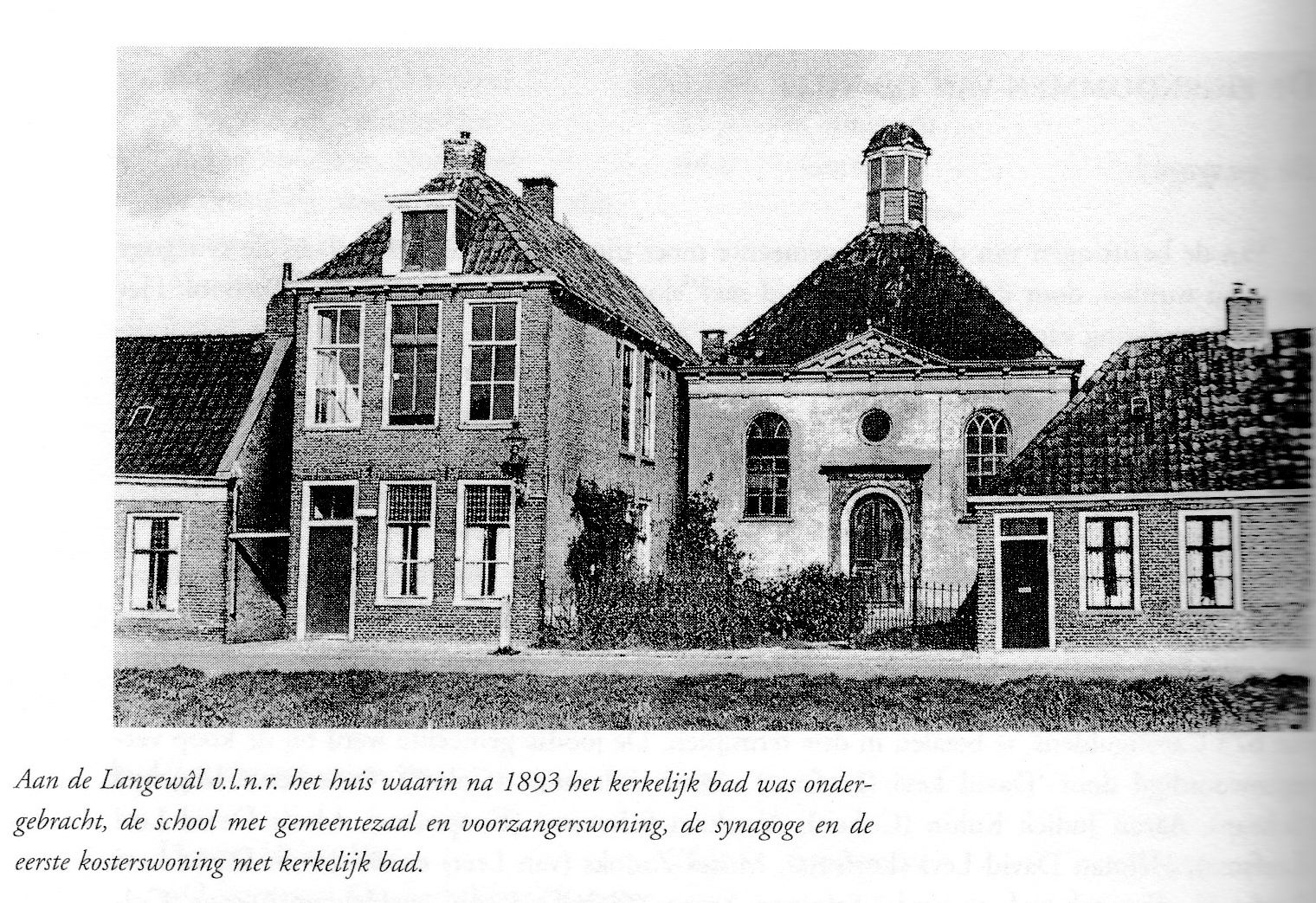 |
| Gorredijk synagogue and adjacent houses |
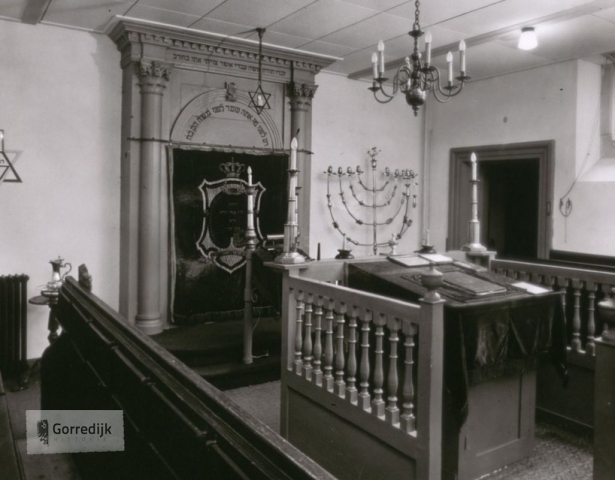 |
| Interior of the Gorredijk synagogue |
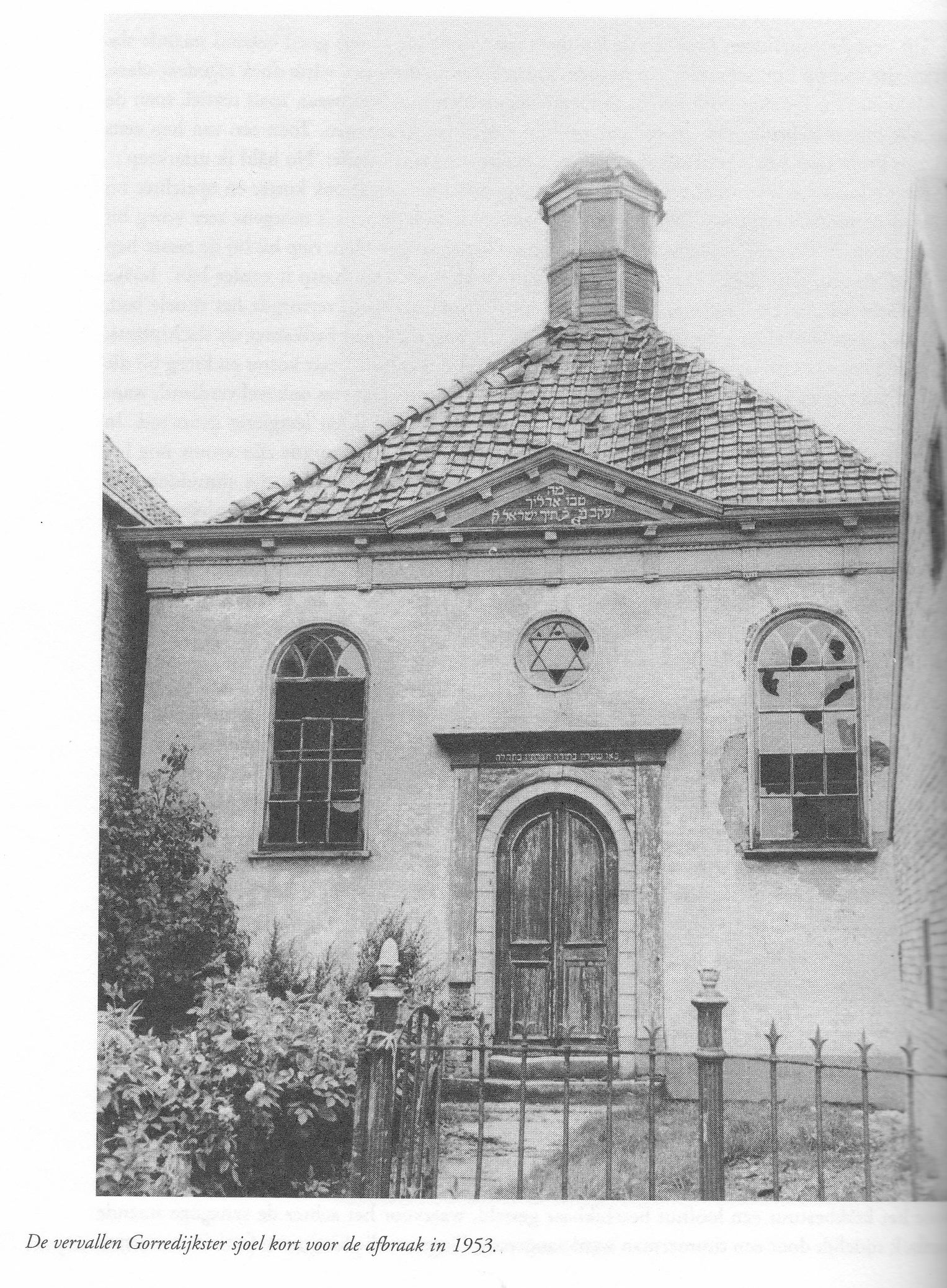 |
| The Gorredijk synagogue before its demolition |
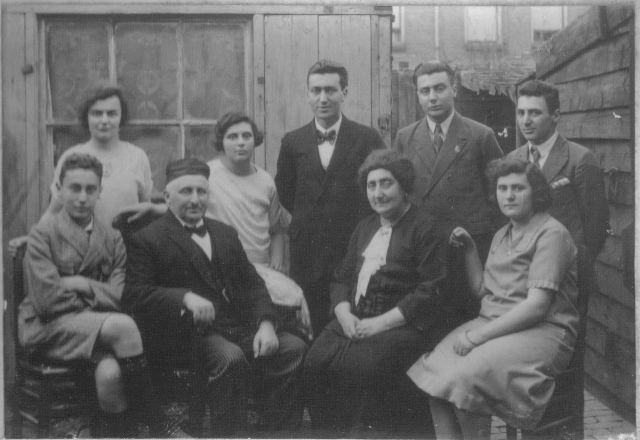 |
| The Colthof family, Gorredijk |
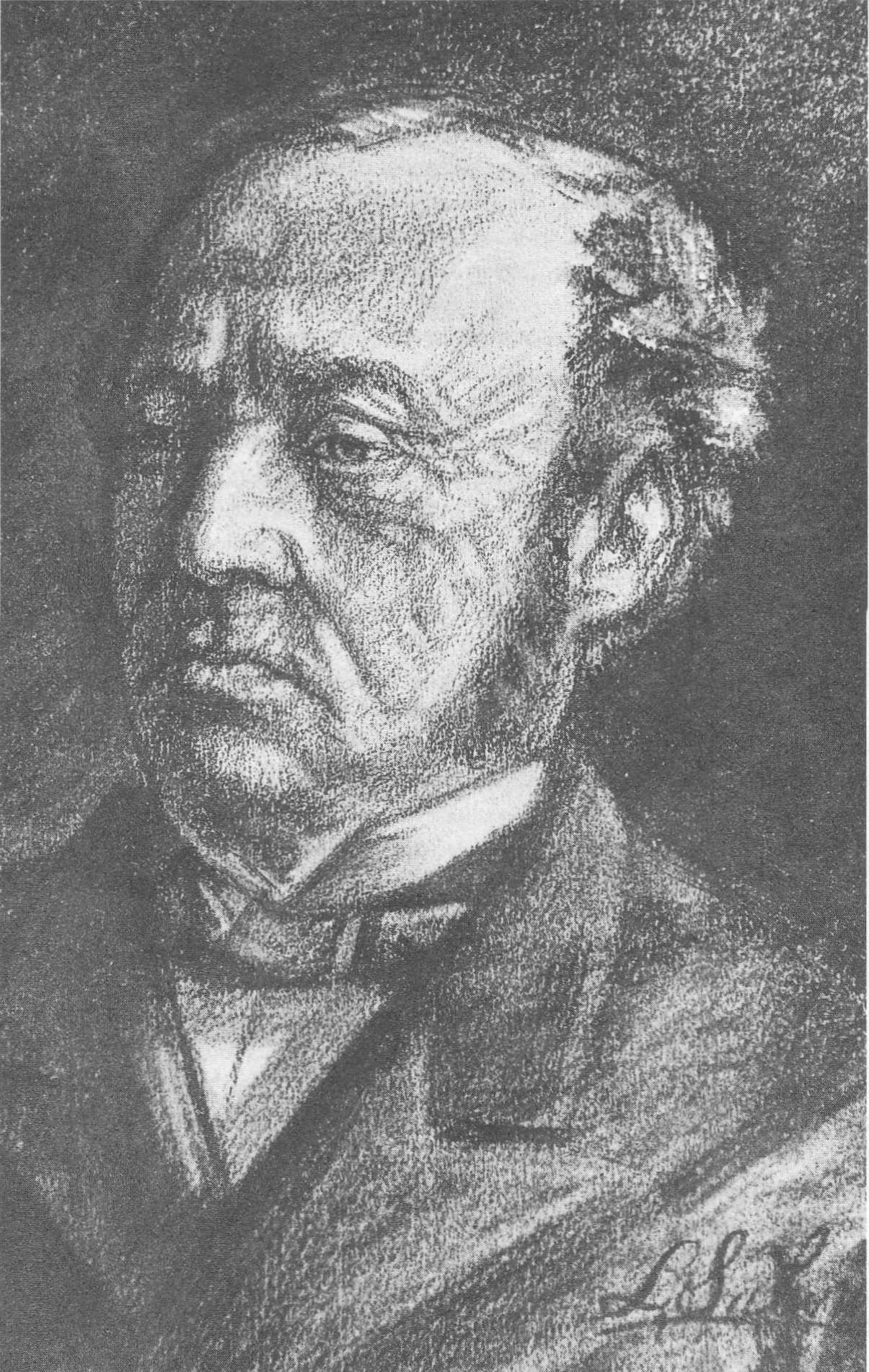 |
| Benedictus David Kalf, "de Gordieker", door L. Salomons |